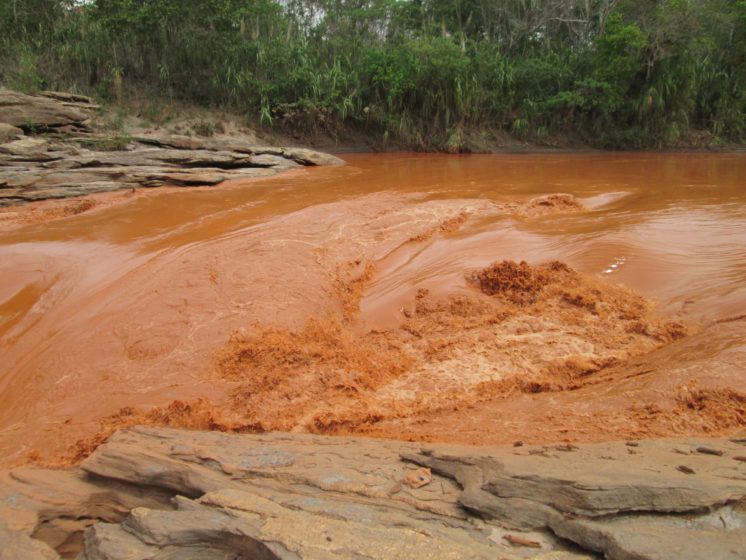Following the collapse of the Fundão dam in 2015, a remedy program was created, but it is difficult for victims of the disaster to access – illustrating how company-led grievance mechanisms may delay remedy.
 Photo: Marcelo Marcelinho, Pixabay, CC0
Photo: Marcelo Marcelinho, Pixabay, CC0Samarco Miceração S.A., a joint venture between BHP and Vale mining companies, operates iron-ore mines in the state of Minas Geras in Brazil. The collapse of the Fundão tailings dam on 15 November 2015 killed 19 people, destroyed three villages and sent 45 million litres of contaminated water into the Doce river basin.
In March 2016, an agreement was signed between the corporations, the federal and local governments and responsible authorities about the actions needed to offset and repair the damages resulting from the dam failure. This agreement led to the creation of the Renova Foundation in June 2016. However, people from the local communities reported that they were not consulted adequately during negotiations and have voiced their disappointment, and even their despair, over their lack of involvement in the workings of the Renova Foundation.[1]
The Brazilian public prosecutor office sought to annul the agreement via the court because of the lack of meaningful participation of affected communities, and succeeded. Another agreement was then negotiated and signed in June 2018 seeking to establishing mechanisms to allow for the participation of those affected by the Rio Doce disaster. However, according to observers, this agreement was again negotiated without involvement of those affected:[2] “We believe that the participation of those affected should have taken place from the start of the development of this mechanism and throughout the whole negotiation period. This agreement, like its predecessors, was signed without the actual participation of the communities affected. There is, once again, a huge disparity in information”, said Juana Kweitel, Executive Director at Conectas.[3]
The Renova foundation claims that it aims to provide multiple forms of reparation to victims of the disaster and their relatives, notably by providing technical assistance to the affected communities; by carrying out an evaluation of the socio-economic impacts of the dam’s collapse; and by providing a grievance mechanism for the victims of the collapse and to their relatives.[4]
However, several research reports have documented the limitations of the Renova Foundation in providing remedy, including limited participation of the victims in the damage calculation methods, the lack of inclusion of immaterial damages, and the disregard of certain groups as affected.[5] Furthermore, victims have experienced administrative roadblocks that prevent the mechanism from being an effective course for remedy. In a report from the Human Rights Law Centre, Caio Borges from Conectas explained:
“The remedy programs are designed to minimize their liability, rather than ensuring proper clean up and justice for the communities affected. They require people seeking to be recognized to complete questionnaire that run to almost 600 pages, and to provide documentary proof of their losses which are [sic] impossible for many people who were informal workers, or those who lost their homes and belongings in the disaster.”[6]
In response to a review request made by the Mind the Gap research team, Vale contests that the Renova Foundation mechanism is burdensome for victims, and declares that the registration process would only take two to four hours for victims to complete and that victims are allowed to self-declare their losses. Furthermore, the company stresses that ”the Renova Foundation has invested R$ 6.68 billion (up until August 2019) in reparation and compensation activities, There are about 7000 workers, 25 universities, and 40 NGOs engaged in the reparation process”. Vale is of the opinion that the qualification of the Renova Foundation mechanism as ineffective is unjustified. [7]
The latest field report by Conectas paints a different picture: “It’s shocking to see how, four years later, the situation remains practically the same. Thousands of people are suffering serious deprivation, because to this day they have not even received emergency assistance,” said Julia Neiva, Socioenvironmental Rights Coordinator at Conectas.[8] This suggests that in November 2019, an important share of the victims affected by the dam collapse still perceived the Renova Foundation remedy program to be ineffective.
[1] Caio Borges and Tchenna Fernandes Maso, “The Collapse of the River Doce Dam”, SUR 14, no. 25 (July 2017): p. 74, https://sur.conectas.org/wp-content/uploads/2017/06/sur-25-ingles-caio-borges-tchenna-fernandes-maso.pdf (accessed October 23, 2019).
[2] Conectas Human Rights. “Requests Special Procedures to Urge Brazilian Public Authorities and the Companies Involved in the Collapse of the Fundão Dam to Refrain from Entering into a New Settlement Agreement without Consultations with the Affected Communities and Civil Society,” June 22, 2018. https://www.conectas.org/wp/wp-content/uploads/2018/06/Doce-River-Update-settlement-agreement-governance.pdf (accessed July 9, 2020).
[3] Conectas Human Rights. “People Affected Excluded from Rio Doce Agreement Negotiations,” June 28, 2018. https://www.conectas.org/en/news/people-affected-excluded-rio-doce-agreement-negotiations (accessed July 9, 2020).
[4] Fundacao Renova. “The Foundation”, https://www.fundacaorenova.org/en/the-foundation/ (accessed July 9, 2020).
[5] Parreiras, Mateus. “Apenas Uma Das 42 Ações de Reparação Do Rompimento de Fundão é Satisfatória,” August 11, 2019. https://www.em.com.br/app/noticia/gerais/2019/11/08/interna_gerais,1099589/apenas-uma-das-42-acoes-de-reparacao-do-rompimento-de-fundao-e-satisfa.shtml (accessed July 9, 2020); Keren Adams, “Nowhere to Turn: Addressing Australian Corporate Abuses Overseas” (Melbourne: Human Rights Law Centre, 2018), 11, https://www.hrlc.org.au/reports/nowhere-to-turn (accessed October 23, 2019).; https://youtu.be/3FIWxzGMYW0; FGV. “Análise Das Matrizes de Danos No Contexto Da Reparação Do Desastre Do Rio Doce,” December 2019. http://www.mpf.mp.br/grandes-casos/caso-samarco/documentos/fgv/fgv_analise-das-matrizes-de-danos-no-contexto-da-reparacao-do-desastre-do-rio-doce.pdf (accessed 9, 2020); Conectas Human Rights. “The Situation of the Affected People, Four Years after the Doce River Tragedy,” May 11, 2019. https://www.conectas.org/en/news/the-situation-of-the-affected-people-four-years-after-the-doce-river-tragedy (accessed July 9, 2020); AgenciaBrasil. “Mariana: 101 Pescadores Sao Reconhecidos Como Vitimas Da Tragedia,” November 9, 2019. https://agenciabrasil.ebc.com.br/geral/noticia/2019-11/mariana-101-pescadores-sao-reconhecidos-como-vitimas-da-tragedia.
[6] Keren Adams, “Nowhere to Turn: Addressing Australian Corporate Abuses Overseas” (Melbourne: Human Rights Law Centre, 2018), 11, https://www.hrlc.org.au/reports/nowhere-to-turn (accessed October 23, 2019).
[7] Vale, “RE: Review announcement case description Vale review”, E-mail received 10 October 2019
[8] Conectas Human Rights. “The Situation of the Affected People, Four Years after the Doce River Tragedy”
